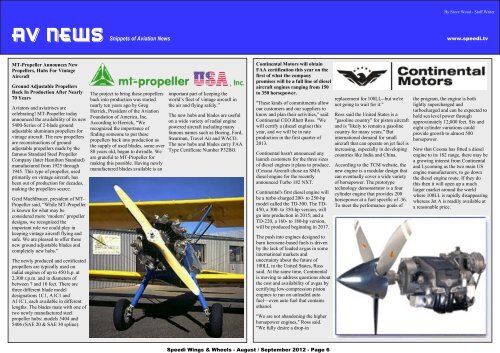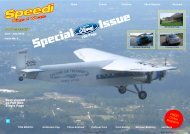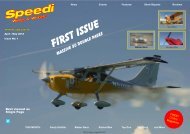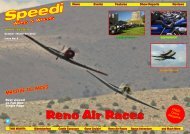Speedi
Issue No: 3 - August / September 2012 - Speedi Wings & Wheels
Issue No: 3 - August / September 2012 - Speedi Wings & Wheels
You also want an ePaper? Increase the reach of your titles
YUMPU automatically turns print PDFs into web optimized ePapers that Google loves.
<strong>Speedi</strong> Wings & Wheels - August / September 2012 - Page 6<br />
By Steve Wood - Staff Writer<br />
Av News<br />
Snippets of Aviation News<br />
www.speedi.tv<br />
MT-Propeller Announces New<br />
Propellers, Hubs For Vintage<br />
Aircraft<br />
Ground Adjustable Propellers<br />
Back In Production After Nearly<br />
70 Years<br />
Aviators and aviatrixes are<br />
celebrating! MT-Propeller today<br />
announced the availability of its new<br />
5400-Series of 2-blade ground<br />
adjustable aluminum propellers for<br />
vintage aircraft. The new propellers<br />
are reconstructions of ground<br />
adjustable propellers made by the<br />
famous Standard Steel Propeller<br />
Company (later Hamilton Standard)<br />
manufactured from 1925 through<br />
1945. This type of propeller, used<br />
primarily on vintage aircraft, has<br />
been out of production for decades,<br />
making the propellers scarce.<br />
Gerd Muehlbauer, president of MT-<br />
Propeller said, “While MT-Propeller<br />
is known for what may be<br />
considered more ‘modern’ propeller<br />
designs, we recognized the<br />
important role we could play in<br />
keeping vintage aircraft flying and<br />
safe. We are pleased to offer these<br />
new ground adjustable blades and<br />
completely new hubs.”<br />
The newly produced and certificated<br />
propellers are typically used on<br />
radial engines of up to 450 h.p. at<br />
2,300 r.p.m. and in diameters of<br />
between 7 and 10 feet. There are<br />
three different blade model<br />
designations 1C1, A1C1 and<br />
A11C1, each available in different<br />
lengths. The blades mate with one of<br />
two newly manufactured steel<br />
propeller hubs: models 5404 and<br />
5406 (SAE 20 & SAE 30 spline).<br />
The project to bring these propellers<br />
back into production was started<br />
nearly ten years ago by Greg<br />
Herrick, President of the Aviation<br />
Foundation of America, Inc.<br />
According to Herrick, “We<br />
recognized the importance of<br />
finding someone to put these<br />
propellers back into production as<br />
the supply of used blades, some over<br />
80 years old, began to dwindle. We<br />
are grateful to MT-Propeller for<br />
making this possible. Having newly<br />
manufactured blades available is an<br />
important part of keeping the<br />
world’s fleet of vintage aircraft in<br />
the air and flying safely.”<br />
The new hubs and blades are useful<br />
on a wide variety of radial engine<br />
powered aircraft including many<br />
famous names such as Boeing, Ford,<br />
Stearman, Travel Air and WACO.<br />
The new hubs and blades carry FAA<br />
Type Certificate Number P32BO.<br />
Continental Motors will obtain<br />
FAA certification this year on the<br />
first of what the company<br />
promises will be a full line of diesel<br />
aircraft engines ranging from 150<br />
to 350 horsepower.<br />
"These kinds of commitments allow<br />
our customers and our suppliers to<br />
know and plan their activities," said<br />
Continental CEO Rhett Ross. "We<br />
will certify a (diesel engine) this<br />
year, and we will be in rate<br />
production in the first quarter of<br />
2013.<br />
Continental hasn't announced any<br />
launch customers for the three sizes<br />
of diesel engines it plans to produce.<br />
(Cessna Aircraft chose an SMA<br />
diesel engine for the recently<br />
announced Turbo 182 NXT.<br />
Continental's first diesel engine will<br />
be a turbo-charged 200- to 250-hp<br />
model called the TD-300. The TD-<br />
450, a 300- to 350-hp version, will<br />
go into production in 2015; and a<br />
TD-220, a 160- to 180-hp version,<br />
will be produced beginning in 2017.<br />
The push into engines designed to<br />
burn kerosene-based fuels is driven<br />
by the lack of leaded avgas in some<br />
international markets and<br />
uncertainty about the future of<br />
100LL in the United States, Ross<br />
said. At the same time, Continental<br />
is moving to address questions about<br />
the cost and availability of avgas by<br />
certifying low-compression piston<br />
engines to run on unleaded auto<br />
fuel—even auto fuel that contains<br />
ethanol.<br />
"We are not abandoning the higher<br />
horsepower engines," Ross said.<br />
"We fully desire a drop-in<br />
replacement for 100LL--but we're<br />
not going to wait for it."<br />
Ross said the United States is a<br />
"gasoline country" for piston aircraft<br />
and is "likely to remain a gasoline<br />
country for many years." But<br />
international demand for small<br />
aircraft that can operate on jet fuel is<br />
increasing, especially in developing<br />
countries like India and China.<br />
According to the TCM website, the<br />
new engine is a modular design that<br />
can eventually cover a wide variety<br />
of horsepower. The prototype<br />
technology demonstrator is a four<br />
cylinder engine that provides 200<br />
horsepower at a fuel specific of .36.<br />
To meet the performance goals of<br />
the program, the engine is both<br />
lightly supercharged and<br />
turbocharged and can be expected to<br />
hold sea level power through<br />
approximately 12,000 feet. Six and<br />
eight cylinder variations could<br />
provide growth to almost 500<br />
horsepower.<br />
Now that Cessna has fitted a diesel<br />
engine to its 182 range, there may be<br />
a growing interest from Continental<br />
and Lycoming as the two main US<br />
engine manufacturers, to go down<br />
the diesel engine route. If they do<br />
this then it will open up a much<br />
larger market around the world<br />
where 100LL is rapidly disappearing<br />
whereas Jet A is readily available at<br />
a reasonable price.





